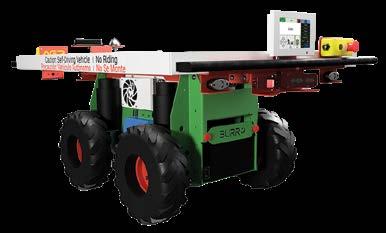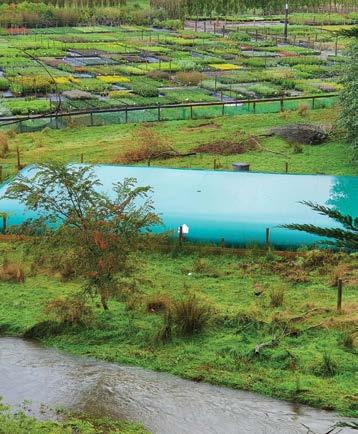
8 minute read
The robots are coming – but not fast enough
FEATURE
ARTICLE
The Burro autonomous platforms are an example of robots working with humans to fill the gaps where there are not enough people to carry out the tasks. Photo: Western Growers
Robotic harvesters are coming, but not fast enough for the worldwide horticultural industry struggling to find people to harvest its crops. ELAINE FISHER reports.
“Horticulture will need humans for some time yet. Designing robots to harvest fruit and vegetables is the hardest challenge the robotics industry faces,” says Walt Duflock vice-president of innovation at Western Growers of Monterey County, who was keynote speaker at the New Zealand Apples & Pears conference in Nelson in August.
“Developing efficient, economically viable harvesters is the hardest challenge to pull off. It’s also hard to get the $20 to $30 million in capital required, and development takes a long time.” In his role at Western Growers (WG), Walt is focused on accelerating commercialisation and helping agtech start-ups to scale their businesses faster, particularly in the areas of harvest automation, food safety and grower trials. Walt is optimistic that robotics capable of harvesting fruit and vegetables will eventually become available, and he is also optimistic that robotics and automation will more quickly have big impacts on other aspects of food production and food safety. “Solutions are nearly ready in the biological space which will help horticulture continue to reduce the use of pesticides, herbicides and fertilisers while maintaining or increasing production.” Many of those solutions will come from startup companies, and collaboration is key to speeding up global agtech innovation. WG through its Western
Growers Global Harvest Automation Initiative is working with start-ups and growers worldwide. Tauranga-based company Robotics Plus Ltd (RPL), which has commercialised the Robotic Apple Packer which packs 120 apples a minute and replaces the cost of up to three people per machine, is part of the initiative. Walt describes Steve Saunders, chief executive, founder and board chairman of RPL as a “legend” in the international world of robotics. The company has also developed a prototype robotic kiwifruit harvester.
For developers and investors, robotics can be either very lucrative or financially disastrous. “What I tell all start-ups is to, as early in the development as possible, talk to growers to find out what problems they need solving and at what economic cost.”
Abundant Robotics of California, which spent six years developing a robot to pick apples, closed its business in mid-2021. “The company was spun out of SRI International and had $19 million in funding from significant investors including Google Ventures, but needed a further $25 million to take the robotic picker to the next level. They failed to raise the funding because they couldn’t convince investors they could get the cost of harvest down from $10 to $20 per apple to 2 cents, which is what it costs to employ people to pick apples.” Walt’s advice to New Zealand agtech start-up businesses is to target international investors and partners to help launch their products faster. He goes further in suggesting that significant advantages would arise from New Zealand and Australian agriculture businesses presenting their combined growing regions as a single significant market for agtech start-ups to enter.
“Together the Australian and New Zealand growing regions probably represent the number two player worldwide, and the advantages for agtech companies are that both countries have very similar growing systems, and their growers speak the same language. It’s much harder to break into the European or Latin American markets where there are multiple countries and multiple languages. The advantage of being a strong worldwide player is getting earlier access to agtech because it takes a while to enter each market, and the higher priority your region is the sooner the agtech arrives.” Among the ways WG also helps start-ups gain traction and


Inhibit russet from developing & promote new growth on young trees with Gib-47™ & Growth™
www.grochem.com

A Western Growers field day in an orchard using a V-trellis growing system suitable for human or robotic harvesting. Photo: Western Growers
funding is through its ‘AgSharks’ competition, held as part of the company’s annual meeting. “It’s like the tv programme Shark Tank but it’s for agtech companies. It’s an opportunity for start-ups to get in front of investors and pitch for investment, but more than that, it’s a 15-minute presentation before 500 WG members, many of them representing billion-dollar businesses.” Among the companies to win investment through AgShark is Burro which makes robots that do not harvest but help increase the efficiency of the labour crew by moving the harvested product from the crew back to the truck for transport. The Burro platforms use computer vision, high precision global positioning systems (GPS), and artificial intelligence (AI) to follow people and navigate autonomously while carrying payloads. “I can’t say enough about the way Charlie Andersen, chief executive of Burro has built that company. It’s been five years of hard slog day after day, fundraising and building a team. He hasn’t won yet, but has a clear path towards winning.” The Burros are an example of robots working with humans to fill the gaps where there are not enough people to carry out the tasks, and Walt says this will be the role of robotics into the future.
Other innovations which will open the pathway to further automation include training fruit trees on systems which make harvesting by robots possible, and easier for humans now. “When I visited New Zealand in August, I saw orchards growing apples using the 2D system. Then three weeks later I visited Yakima County in Washington, where I saw apples growing on V-trellis and wall trellis systems and higher density seven-foot (2.1336m) trees which enabled pickers to use low three-level working platforms, reducing a lot of the vertical risk of harvesting. And yet, because of improved farm practices and trial and error, yields in the seven-foot orchard with higher tree density were equivalent to or better than the wall or V-trellis architecture in other orchards.”
All these growing systems will be suitable for robotic harvesters when they are commercially available, but in the meantime, are producing significant increases in crop production. “One Washington orchard using V-trellis training yielded almost double the standard orchard production. “I think genetics will have a big part to play in the move to robotic harvesting, as seen in the seven-foot apple trees and in the High Rise™ broccoli by Seminis Vegetable Seeds.”
High Rise varieties grow tall and have a strong, clean stem with visible crowns and few large leaves. Available in New Zealand, the taller broccoli will be more suitable for robotic harvesting than other varieties. Automation is also affecting the task of crop weeding. Carbon Robotics’ laser weeding robot has sophisticated artificial intelligence technology which enables the robot to move through crops, instantly identifying, targeting and eliminating weeds using thermal energy.

Other technology now widely available includes the kind of comprehensive ‘dashboards’ from big brands like John Deere which enable growers to track where tractors are and what they are doing. There are also field sensors collecting data around soil health and water. Technology can also track the output of a harvest crew, down to the performance of each worker. “With that information, received in real time, rather than at the end of each day, a farmer can assess the true value of each of his fields or blocks by measuring the income against the costs of inputs, equipment and labour.” While not all the technology horticulture and farming needs is available right now, Walt believes advances are coming fast which will solve many of the issues around greenhouse gases, water quality, the environment and global warming, and at the same time help increase food production. “In countries which have a choice to innovate or regulate, I say incentivise growers and farmers to innovate. “Many sectors in agriculture and horticulture worldwide are already using 95 percent less inputs while producing three to four times the food, depending on the commodity involved. The way industries have done that is through the use of more efficient genetics to produce more, while using fewer inputs.” Walt warns that over-regulation can result in severe consequences, citing what happened in Sri Lanka in 2021 when the then president, Gotabaya Rajapaksa, banned synthetic fertiliser and pesticide imports practically overnight, forcing Sri Lanka’s millions of farmers to go organic. “Many other factors were at play, but that decision helped lead to an horrific series of events which resulted in the overthrow of the government. There were not enough workers to manually control pests so food production dropped, and then there were not enough people to harvest what was grown, which resulted in food shortages and people going hungry.”
Many agriculture and horticulture sectors around the world are already using 95 percent less inputs while producing three to four times the food
The Burro platforms use computer vision, high precision GPS, and AI to follow people and navigate autonomously while carrying payloads

www.precisede.co.nz Angus Clarke 027 498 3146 Allan Crouch 021 909 463










